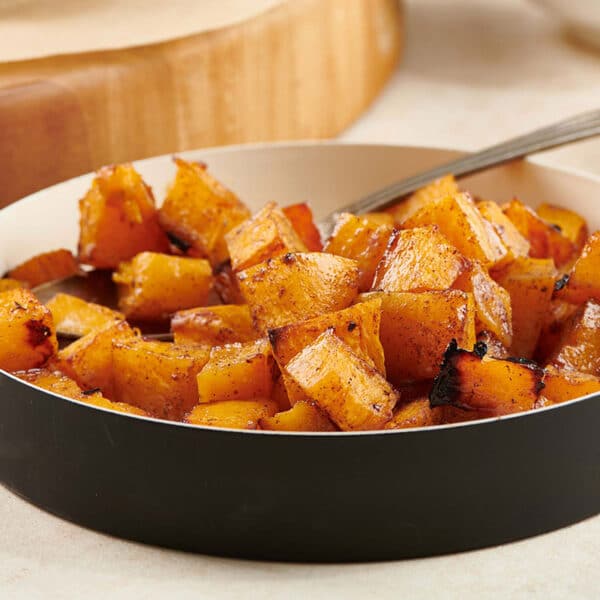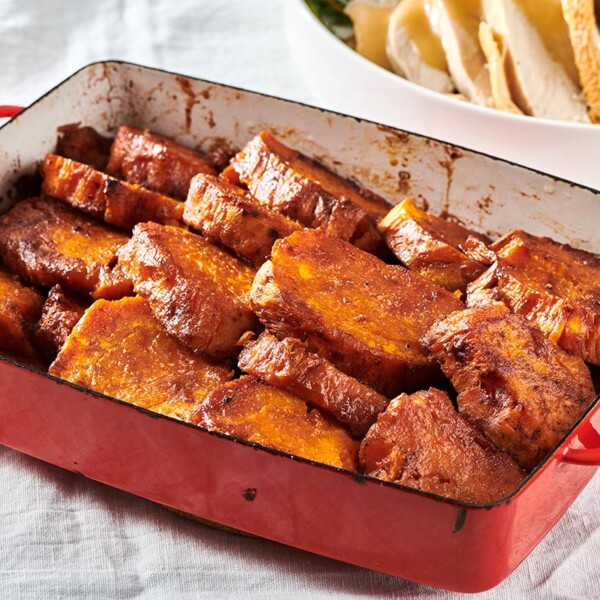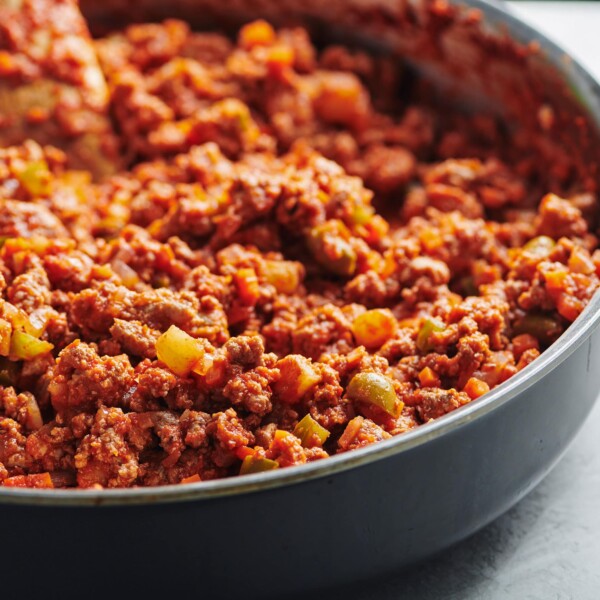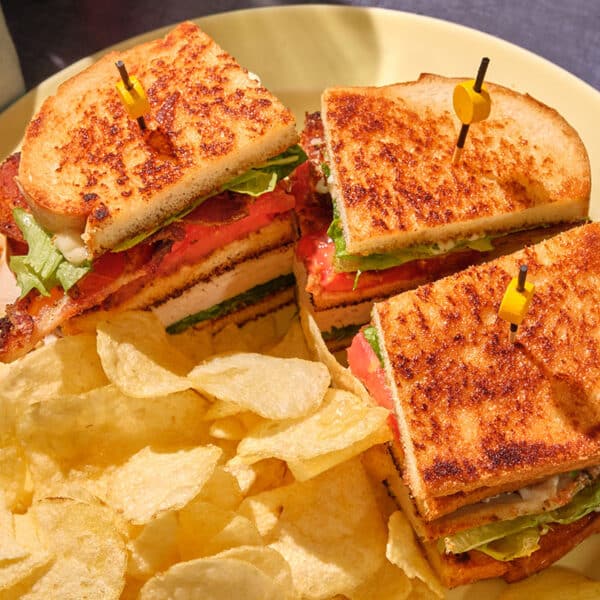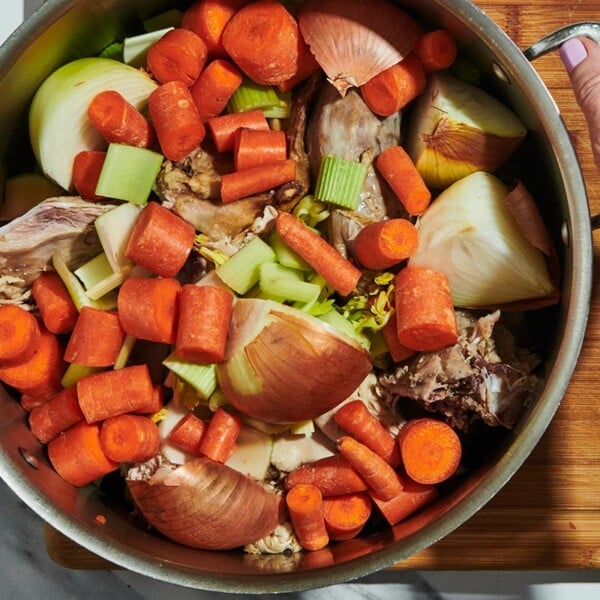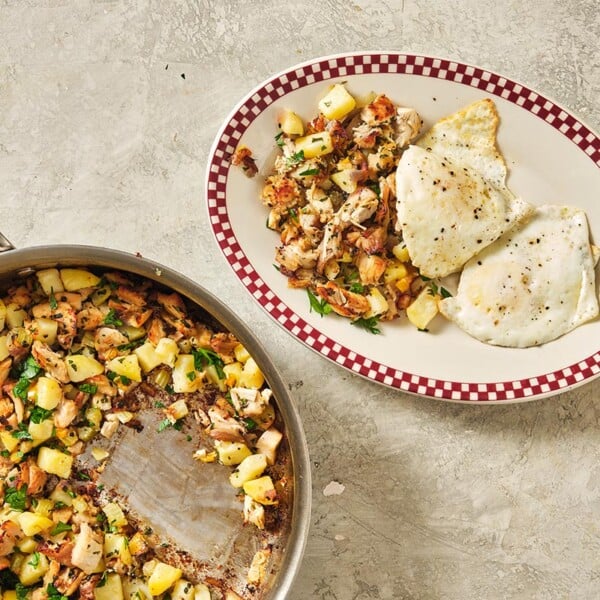Cajun Roasted Turkey
on Nov 05, 2023, Updated Sep 25, 2024
This post may contain affiliate links. Please read our disclosure policy.
A twist on the classic roast turkey; tender meat and crispy skin with those great Cajun seasonings.

Even though my family is quite traditional when it comes to our Thanksgiving fare, this Cajun-style turkey recipe is a very welcome change of pace. It’s definitely still a classic roasted turkey, with crisp mahogany skin and tender, moist meat, but thanks to the seasoning rub, it has a little Southern flair! It’s not too spicy, but it has a touch of smokiness and heat and a whole lot of flavor.
While some Cajun turkey recipes include an injection of seasonings, this one does not, so it’s much more accessible for the home cook. The Cajun spices are blended into softened butter with a bit of olive oil and rubbed all over the bird, which marinates for a few days in the fridge. That’s what gives the whole turkey such great depth of flavor; the seasoned butter rub acts as sort of a marinade, sort of a brine.
By signing up, you agree to our Privacy Policy.
This turkey pairs well with Southern sides and also with traditional Thanksgiving sides. Think about Cranberry Sauce, Fresh Green Bean Casserole, and Mashed Potatoes.
Don’t just think of this for Thanksgiving! It would make a terrific centerpiece to any big gathering, especially a Southern-style meal. I know we would be delighted to see it paired up with Cornbread or Cornbread Dressing, Collard Greens, Candied Sweet Potatoes, Butter-Roasted Sweet Potatoes, and some Grits or maybe Dirty Rice. I might also add some of the leftovers to a Cajun Jambalaya.
What's In This Post?
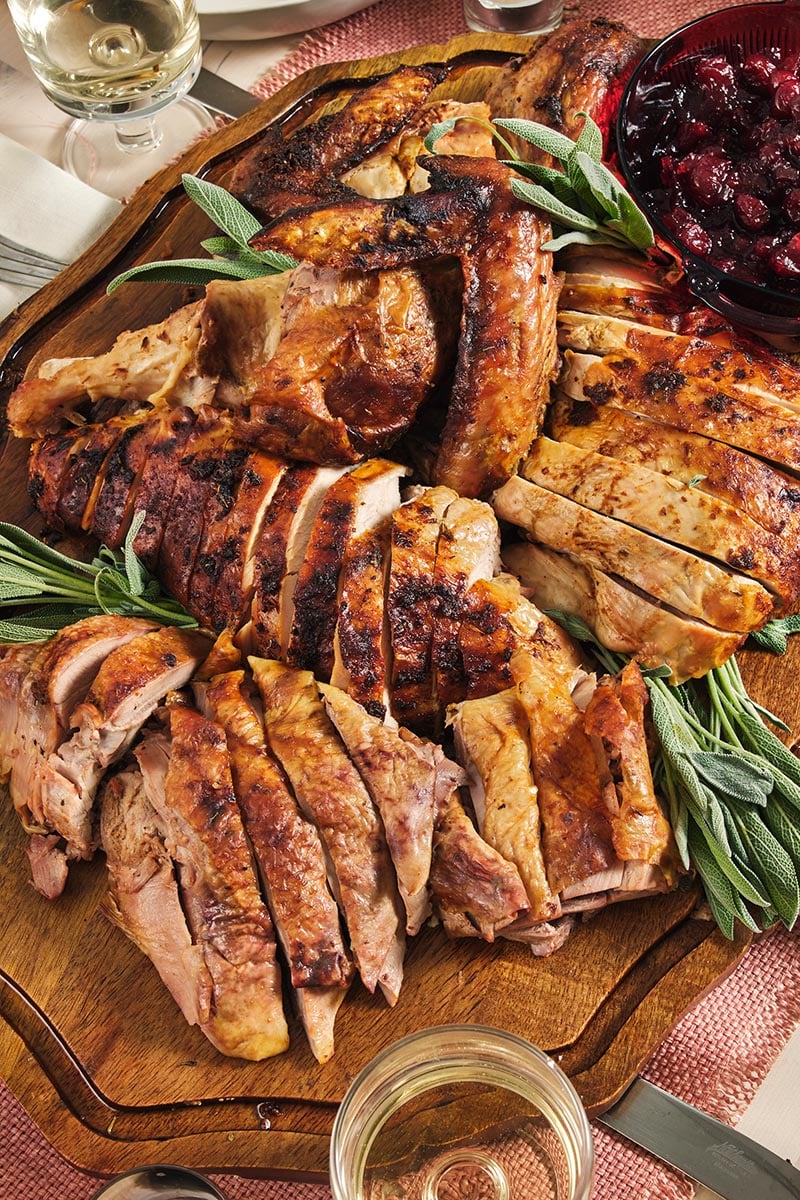
Cajun Roasted Turkey: A twist on the classic roast turkey; tender meat and crispy skin with those great Cajun seasonings.
Ingredients
For the Cajun Rub:
The amount of rub is designed for a 12-pound turkey, but unless your turkey is significantly bigger, it should be sufficient. If your turkey is 18 pounds or more, make another half recipe of the Cajun butter blend.
- Paprika – Use sweet or regular paprika, not hot or smoked, or the flavor will be too overpowering.
- Kosher salt – Salt is essential to season the turkey (in a sense, creating a dry brine) and keep it moist.
- Garlic powder – Garlic powder has a distinct flavor from fresh garlic. Go with the powder here.
- Onion powder – Rounds out the flavors with a toasty sweetness.
- Dried oregano and thyme – Use dried herbs instead of fresh here, as they pack a bigger punch and blend well into the rub.
- Ground black pepper – Fresh ground black pepper is always better than the pre-ground stuff.
- Cayenne pepper – Adds the signature smoky spice familiar to Cajun food lovers.
- Unsalted butter – The herbs and spices are blended into some softened butter and olive oil, and then that mixture is rubbed all over the turkey.
- Olive oil – A mixture of butter and oil keeps the turkey moist and flavorful throughout the roasting process.
For the Turkey:

- Turkey – 12 to 16 pounds, preferably fresh, defrosted if frozen. Remove the giblets and neck and reserve for gravy if desired!
- Orange – Stuffed into the turkey cavity, this adds a light citrusy flavor to the bird.
- Yellow onions – Peeled and halved, also for stuffing into the turkey to add another layer of flavor.
- White wine – Optional, but adds flavor and helps keep the turkey moist.
- Chicken broth – Also provides flavor and moisture.
How to Make Cajun Roasted Turkey
- Make the rub: In a small bowl, combine the seasonings. Use a fork to squish in the softened butter and oil until completely blended.
- Season the turkey: Pat the turkey dry. Rub the seasoned butter mixture all over the bird, working some of the butter underneath the skin.
- Let the turkey sit well-wrapped overnight: Two days before roasting, place the turkey into a large plastic bag, preferably a sealable one, press out the air, and seal it tight. Place the turkey in a roasting pan, breast side up, in the refrigerator for 24 hours.
- Let the turkey sit uncovered overnight: After a day, and 1 day before roasting, remove the bird from the fridge and take it out of the plastic bag. Do not rinse the bird. Place the turkey on a rack in the roasting pan or on a plate, and refrigerate uncovered for another 24 hours.
- Roast the turkey: Bring the turkey to room temperature. Place the turkey in the roasting pan, pour the wine and chicken broth into the pan around the turkey, and roast, basting occasionally, until an internal meat thermometer registers 165 degrees in the thickest part of the thigh.
- Serve: Let rest for about 20 to 30 minutes. Carve the turkey and serve. Sprigs of fresh thyme or sage make pretty garnishes for the platter.

FAQs
Roasting a turkey takes anywhere from 2 to 6 hours to complete, and the time varies depending on the size of your bird. The best way to be sure that it is done cooking is to use an internal thermometer. The thickest part of the thigh should register 165 degrees.
Roasting a turkey at a lower temperature helps it stay moist and cook all the way through evenly. It also prevents the spiced butter rub from turning too dark brown. An oven temp of 325 degrees is a perfect temperature for this. Higher temperatures may result in dry, overcooked breasts or undercooked thighs and legs when the breasts are perfectly done.
It is important to allow a turkey to rest after it comes out of the oven. It may be tempting to dig in right away, but covering the turkey with aluminum foil and allowing it to rest for at least 20 minutes will make sure that its natural juices stay in the meat. If you cut and serve your turkey right out of the oven, the juices will run out, and it will become dry.
Cooking Tips
- If, as the turkey is cooking, the top starts to get too browned, just tent a large piece of foil over the top of the bird.
- When the turkey is finished cooking, remove it to a cutting board with a moat, tipping any juices that have accumulated in the turkey back into the roasting pan. Let the turkey sit, tented with aluminum foil, for at least 20 minutes.
- While the turkey is resting, pour all of the liquid from the roasting pan into a large measuring cup. Put it into the fridge, and when the fat has risen to the top, use a spoon to scrape off the fat and discard it. You can also use a fat separator for this purpose. You may also want to make gravy, but know that you will have a Cajun-style gravy to go with your Cajun-style turkey.
- The rub might clump up a bit as the bird cooks. You can take a basting brush dipped in olive oil to smooth out the rub over the skin towards the end of the roasting process or as you take it from the oven.

Storage and Leftovers
When stored in the fridge, leftover turkey will last in an airtight container for at least 4 days. You can also freeze it for up to 6 months; wrap leftovers well in plastic wrap and then slide them into a zip-top bag and press out any excess air.
Leftover Cajun turkey makes the most amazing sandwiches. Please make sure the turkey you prepare is bigger than you need so you have the opportunity to enjoy it again later in the week!
What to Serve With Cajun Turkey
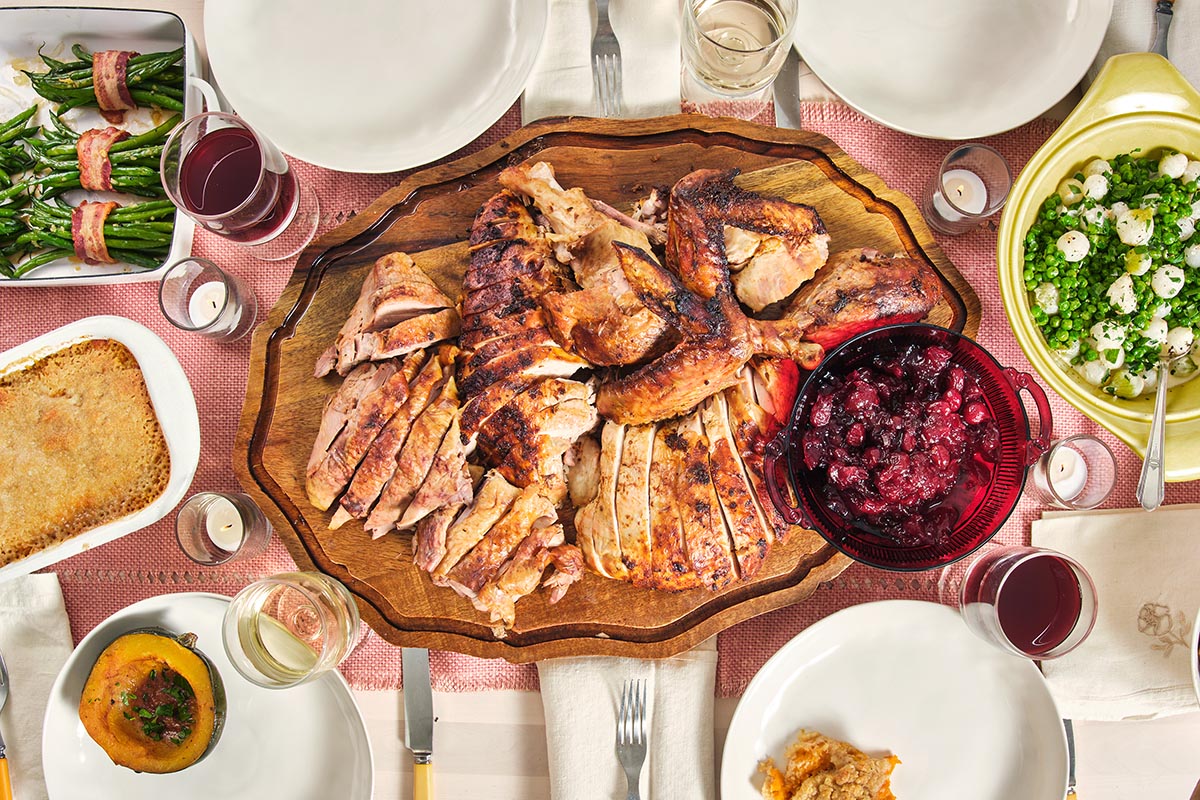
More Turkey Tips
- How to Brine a Turkey Breast
- How to Carve a Turkey
- How to Safely Defrost Turkey
- How to Freeze and Defrost Leftover Turkey
Pin this now to find it later
Pin It
Cajun Roasted Turkey
Equipment
Ingredients
For the Cajun Rub:
- 4 tablespoons paprika
- 2 tablespoons kosher salt
- 2 tablespoons garlic powder
- 2 tablespoon onion powder
- 1 tablespoon dried oregano
- 1 tablespoon dried thyme
- 1 tablespoon black pepper
- 2 teaspoons cayenne pepper
- ½ cup (1 stick) unsalted butter (softened; divided)
- 2 tablespoons olive oil
For the Turkey:
- 1 (12-pound) turkey (preferably fresh, defrosted if frozen, giblets and neck removed and reserved for another use; see gravy!)
- 1 orange (halved)
- 2 medium yellow onions (peeled and halved)
- 1 cup white wine (optional)
- 1 cup chicken broth
- freshly ground black pepper (to taste)
Instructions
- In a small bowl, combine the paprika, salt, garlic powder, onion powder, oregano, thyme, black pepper, and cayenne. Use a fork to squish in the softened butter and oil until completely blended.
- Pat the turkey dry with paper towels. Rub the seasoned butter all over the bird, legs, thighs, breasts, everywhere. Carefully lift the skin where possible and work some of the butter underneath the skin. Also, rub some inside the cavity of the bird. Place the turkey into a large plastic bag, preferably a sealable one, press out the air, and seal it tight. Place the turkey in a roasting pan, breast side up, in the refrigerator for 24 hours.
- After a day (and 1 day before Thanksgiving), remove the bird from the fridge and take it out of the plastic bag. Do not rinse the bird. Place the turkey on a rack in the roasting pan or on a plate, and refrigerate uncovered for another 24 hours.
- Remove the turkey from the fridge 1 hour before cooking to allow it to come to room temperature. Preheat the oven to 325 F. Place a rack in the lower third of the oven, and make sure you raise or remove the upper racks so the turkey can fit with room to spare on top.
- Place the orange and onion halves into the cavity of the bird. Tuck the wings behind the back of the bird and place it in a rack in a roasting pan breast side up. Tie the legs closed (some birds have a cool little plastic gadget that holds the legs together, which will keep the cavity closed). Make sure the turkey is breast side up on the rack in the roasting pan, and place the pan into the oven.
- Pour the wine and chicken broth into the pan around the turkey. Place the pan in the oven. After 1 hour, baste the bird with the juices from the bottom of the pan. Baste every 30 minutes from here on out until the turkey is almost done, then stop to maintain the crispy skin.
- Start checking after 2 hours with an internal thermometer, sticking it into the deepest part of the thigh and making sure that it does not touch bone. The internal temperature should be 165 F. If as the turkey is cooking, the top starts to get too browned just tent a large piece of tin foil over the top of the bird.
- When the turkey is finished cooking, remove it to a cutting board with a moat, tipping any juices that have accumulated in the turkey back into the roasting pan. Let the turkey sit, tented with foil, for at least 20 minutes.
- While the turkey is resting, pour all of the liquid from the roasting pan into a large measuring cup. Put it into the fridge, and when the fat has risen to the top, use a spoon to scrape off the fat and discard it. You also can use a fat separator for this purpose. You may also want to make gravy, but know that you will have a Cajun-style gravy to go with your Cajun-style turkey!
- Carve the turkey and serve.

